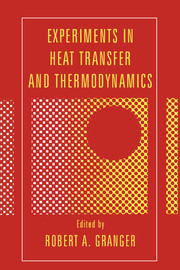Book contents
- Frontmatter
- Contents
- Preface
- Introduction
- Part I Experiments in heat transfer
- I.1 Conduction
- I.2 Convection
- Experiment 7 A forced convection heat-transfer experiment
- Experiment 8 Reynolds analogy for mass transfer
- Experiment 9 Natural-convection melting of a slab of ice
- Experiment 10 Forced-convection heat loss from 3D solids
- Experiment 11 Forced and free convective heat transfer of a laminar flow in a horizontal heated pipe
- Experiment 12 Measurement of convective heat-transfer coefficients on external surfaces
- Experiment 13 Measurement of local heat-transfer coefficient on the ice surface around isothermally cooled cylinders arranged in a line
- Experiment 14 Experiments of unsteady forced convection in ducts with timewise variation of inlet temperature
- Experiment 15 Measurement of heat and mass transfer from a body in air–water mist flow
- Experiment 16 Measurement of transient/steady heat-transfer coefficient with simultaneous photography of flow processes from beneath the heater surface
- I.3 Boiling
- I.4 Mixing, dispersion, and diffusion
- I.5 Radiation
- I.6 Heat pipes and exchangers
- Part II Experiments in thermodynamics
- Appendix 1 Experiments and demonstrations in thermodynamics
- Appendix 2 Experiments and demonstrations in heat transfer
- Appendix 3 Heat-transfer and thermodynamic films
- Index
Experiment 12 - Measurement of convective heat-transfer coefficients on external surfaces
Published online by Cambridge University Press: 05 June 2012
- Frontmatter
- Contents
- Preface
- Introduction
- Part I Experiments in heat transfer
- I.1 Conduction
- I.2 Convection
- Experiment 7 A forced convection heat-transfer experiment
- Experiment 8 Reynolds analogy for mass transfer
- Experiment 9 Natural-convection melting of a slab of ice
- Experiment 10 Forced-convection heat loss from 3D solids
- Experiment 11 Forced and free convective heat transfer of a laminar flow in a horizontal heated pipe
- Experiment 12 Measurement of convective heat-transfer coefficients on external surfaces
- Experiment 13 Measurement of local heat-transfer coefficient on the ice surface around isothermally cooled cylinders arranged in a line
- Experiment 14 Experiments of unsteady forced convection in ducts with timewise variation of inlet temperature
- Experiment 15 Measurement of heat and mass transfer from a body in air–water mist flow
- Experiment 16 Measurement of transient/steady heat-transfer coefficient with simultaneous photography of flow processes from beneath the heater surface
- I.3 Boiling
- I.4 Mixing, dispersion, and diffusion
- I.5 Radiation
- I.6 Heat pipes and exchangers
- Part II Experiments in thermodynamics
- Appendix 1 Experiments and demonstrations in thermodynamics
- Appendix 2 Experiments and demonstrations in heat transfer
- Appendix 3 Heat-transfer and thermodynamic films
- Index
Summary
Principle
The lumped-mass assumption (negligible internal thermal resistance) is used to infer forced-, natural-, or mixed-convection heat-transfer coefficients on spheres, cylinders, and other shapes.
Objective
This experiment allows the estimation of heat-transfer coefficients that result from external flows. Use of the lumped-mass approximation is a key element to the work, and this experiment can be used to explore the limits of this important experimental convective technique. Also of value is the estimation of the radiation contribution compared to the convective contribution in the total heat loss from a heated object. The basic approach can be used for a variety of geometries in forced-, free-, or mixed-convection arrangements. The description here focuses on forced-convection applications, but the basic apparatus and concept can be used for the other situations as well.
Apparatus
Constant-speed centrifugal fan with uniform flow outlet and damper on inlet (for forced-flow experiments)
Hand-held anemometer, propeller type (for forced-flow experiments)
Thermocouple reference junction and signal readout device (many data loggers combine these functions and can be used). A highly desirable alternative is a computer-based data acquisition system.
Clock (if time is not recorded with data logger or computer)
Support stand
Bunsen burner and lighter
Two thermocouples, one in ambient air and one with adaptor for test element
Barometer
Copper test elements (e.g., sphere, cylinder)
A diagram of the test apparatus suitable for forced-flow experiments is shown in Fig. 12.1.
- Type
- Chapter
- Information
- Experiments in Heat Transfer and Thermodynamics , pp. 76 - 81Publisher: Cambridge University PressPrint publication year: 1994
- 1
- Cited by



